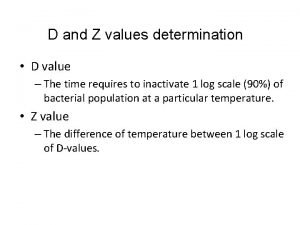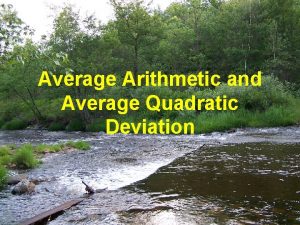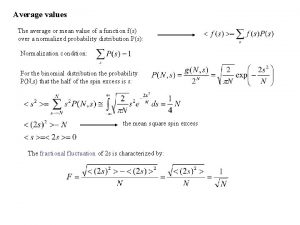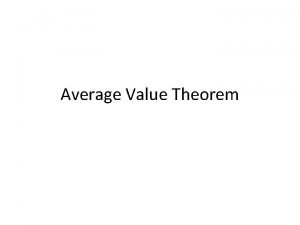4 4 Average Value and Physics Connections Average










- Slides: 10

4. 4 Average Value and Physics Connections

Average Value of a Function The average value of a continuous function f(x) on some interval from a to b is given by the equation It looks like an average, doesn’t it.

Example Find the average value of the function on the interval from 1 to 5

Physics The relationship between velocity v(t), acceleration a(t) and position x(t) is this: To use this we need to understand 2 definitions.

Net Change vs Total Distance If you drive to Starbucks then back (and park in the very same parking place) your net change is 0, right? But, the odometer value has changed. That is, the total distance traveled is NOT zero. This works in physics when a particle is moving along a straight line path (typical situation)

Net Change = displacement = net change in the position of a body moving along a line from a to b. Mathematically where some distances will be positive (“up” or “forward) while others will be negative (“down” or “backward”). The Net change is the result of these movements.

Total Distance = the sum of all the distances. Therefore, you will need to know where it changes from + to – directionally, and add the absolute values of all these.

WHAT? Imagine. A particle moves forward 10 m then backwards 7 m. Net Change? 3 m Total Distance? 17 m

Well, how do I do that? Often, a sketch of the velocity is a very good idea. This will quickly identify where the distance is positive and where it is negative. Take the absolute value of anything negative and add all of these numbers.

Examples 1. Given that a particle travels according to the equation Find the net change AND the total distance traveled by the particle. Homework: Worksheet
 Contoh value creation
Contoh value creation What is the difference between speed and velocity
What is the difference between speed and velocity Modern physics vs classical physics
Modern physics vs classical physics University physics with modern physics fifteenth edition
University physics with modern physics fifteenth edition Good physics ia topics
Good physics ia topics In the previous lesson i learned that accounting
In the previous lesson i learned that accounting How to find p value from t statistic
How to find p value from t statistic D value and z value
D value and z value Acid value principle
Acid value principle Creating value and capturing value
Creating value and capturing value Cdci binghamton
Cdci binghamton


















